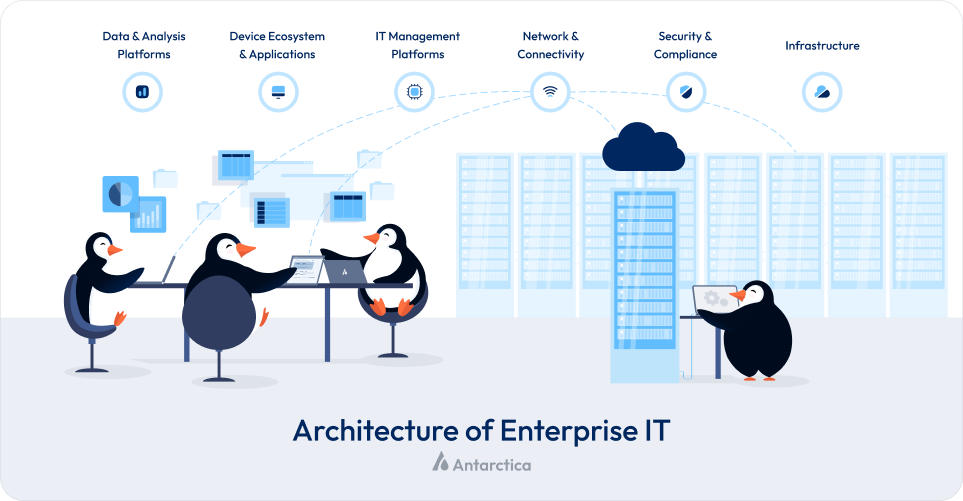Antarctica Methodology for Enterprise Sustainable Digital Transformation
Published on : 20-01-2025 by Antarctica Global Technology & Consulting Pvt. Ltd.

Enterprises worldwide are undergoing digital transformations to stay competitive in an increasingly tech-driven economy. However, this shift is not without its challenges, particularly in the realm of observability and sustainability. Research indicates that 70% of enterprise digital transformation efforts fail, often due to a lack of comprehensive observability into the organisation’s IT ecosystem. The complexity of managing an expanding ICT stack—spanning cloud and on-premise environments, device ecosystems, IoT deployments, and enterprise websites—has resulted in fragmented data silos and inconsistent oversight.
This fragmentation poses a dual challenge for enterprises: the lack of a unified view of IT operations hampers resource optimisation and alignment with business objectives, while the absence of standardised methodologies to measure and manage the environmental impact of digital operations undermines sustainability efforts. The ICT industry emits 4% of global GHG emissions today, and within that Enterprise IT, responsible for 1% —equivalent to the carbon footprint of the United Kingdom—faces emissions from diverse sources, including data centres, devices, and digital services. Existing frameworks fail to quantify these emissions holistically, as IT asset data, from device inventories to SaaS license usage and cloud consumption, remains siloed across departments, spreadsheets, and fragmented management platforms. These platforms typically include a complex web of MDMs and IT service management (ITSM), digital asset management (CMDB), IT monitoring (ITOM), enterprise service management (ESM) and remote support, making comprehensive analysis nearly impossible.
This whitepaper presents a structured methodology for addressing these challenges through Antarctica’s Proprietary Sustainable IT solution. Antarctica’s SaaS consolidates fragmented Enterprise IT usage into a single, cohesive framework, offering enterprises a unified view of their digital operations. Beyond integration, the solution embeds a robust layer of sustainability, leveraging advanced methodologies to calculate and visualise emissions across an enterprise IT stack.
By uniting data observability and sustainability metrics, Antarctica’s proprietary methodology enables enterprises to achieve two critical objectives. First, it establishes a clear, quantifiable baseline for beginning your digital transformation efforts. Second, it provides actionable insights for optimising IT operations, reducing emissions, and aligning digital strategies with enterprise-level environmental, social, and governance (ESG) goals. With these two objectives in mind, this paper details the technical methodologies underpinning the solution, illustrating how usage, finance, energy consumption and emissions are measured across diverse IT infrastructure components.
Enterprise IT refers to the integrated suite of hardware, software, cloud and network infrastructure designed to meet the complex needs of businesses. It supports critical operations, ensures cybersecurity, drives innovation, and underpins strategic business objectives. The architecture of enterprise IT spans several key domains, each contributing uniquely to operational efficiency and scalability.

Understanding and addressing the digital carbon footprint of enterprise IT requires a systematic approach that considers every component of the ICT stack. Every action and process within an enterprise IT ecosystem—whether accessing cloud resources, migrating cloud workloads, running on-premise infrastructure, deploying applications, or utilising SaaS licenses—consumes electricity, leading to emissions. This relationship between digital activity, energy consumption, and environmental impact forms the foundation of Antarctica’s methodology.

Antarctica integrates with existing enterprise IT workflows, adhering to robust data privacy and security standards. By leveraging single sign-on (SSO), connect your HRIS, Google Workspace or MS365 to import all enterprise users and devices in one go. Data privacy and security are built-in, with compliance to GDPR, ISO 27001, and other international standards. Crucially, all data resides within organisation control, eliminating external dependencies and ensuring full regulatory alignment.
Once deployed, Antarctica consolidates fragmented data streams into a single, intuitive dashboard, providing a 360-degree view of an enterprise IT landscape. The platform integrates device telemetry, cloud consumption data, SaaS license utilisation, and website and network performance metrics into one platform.